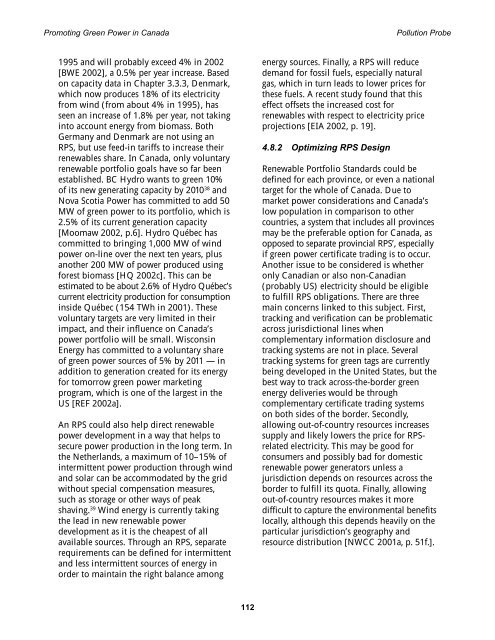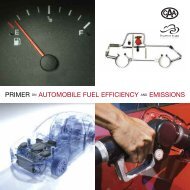Promoting Green Power in Canada - Centre for Human Settlements
Promoting Green Power in Canada - Centre for Human Settlements
Promoting Green Power in Canada - Centre for Human Settlements
- No tags were found...
You also want an ePaper? Increase the reach of your titles
YUMPU automatically turns print PDFs into web optimized ePapers that Google loves.
<strong>Promot<strong>in</strong>g</strong> <strong>Green</strong> <strong>Power</strong> <strong>in</strong> <strong>Canada</strong> Pollution Probe1995 and will probably exceed 4% <strong>in</strong> 2002[BWE 2002], a 0.5% per year <strong>in</strong>crease. Basedon capacity data <strong>in</strong> Chapter 3.3.3, Denmark,which now produces 18% of its electricityfrom w<strong>in</strong>d (from about 4% <strong>in</strong> 1995), hasseen an <strong>in</strong>crease of 1.8% per year, not tak<strong>in</strong>g<strong>in</strong>to account energy from biomass. BothGermany and Denmark are not us<strong>in</strong>g anRPS, but use feed-<strong>in</strong> tariffs to <strong>in</strong>crease theirrenewables share. In <strong>Canada</strong>, only voluntaryrenewable portfolio goals have so far beenestablished. BC Hydro wants to green 10%of its new generat<strong>in</strong>g capacity by 2010 38 andNova Scotia <strong>Power</strong> has committed to add 50MW of green power to its portfolio, which is2.5% of its current generation capacity[Moomaw 2002, p.6]. Hydro Québec hascommitted to br<strong>in</strong>g<strong>in</strong>g 1,000 MW of w<strong>in</strong>dpower on-l<strong>in</strong>e over the next ten years, plusanother 200 MW of power produced us<strong>in</strong>g<strong>for</strong>est biomass [HQ 2002c]. This can beestimated to be about 2.6% of Hydro Québec’scurrent electricity production <strong>for</strong> consumption<strong>in</strong>side Québec (154 TWh <strong>in</strong> 2001). Thesevoluntary targets are very limited <strong>in</strong> theirimpact, and their <strong>in</strong>fluence on <strong>Canada</strong>’spower portfolio will be small. Wiscons<strong>in</strong>Energy has committed to a voluntary shareof green power sources of 5% by 2011 — <strong>in</strong>addition to generation created <strong>for</strong> its energy<strong>for</strong> tomorrow green power market<strong>in</strong>gprogram, which is one of the largest <strong>in</strong> theUS [REF 2002a].An RPS could also help direct renewablepower development <strong>in</strong> a way that helps tosecure power production <strong>in</strong> the long term. Inthe Netherlands, a maximum of 10–15% of<strong>in</strong>termittent power production through w<strong>in</strong>dand solar can be accommodated by the gridwithout special compensation measures,such as storage or other ways of peakshav<strong>in</strong>g. 39 W<strong>in</strong>d energy is currently tak<strong>in</strong>gthe lead <strong>in</strong> new renewable powerdevelopment as it is the cheapest of allavailable sources. Through an RPS, separaterequirements can be def<strong>in</strong>ed <strong>for</strong> <strong>in</strong>termittentand less <strong>in</strong>termittent sources of energy <strong>in</strong>order to ma<strong>in</strong>ta<strong>in</strong> the right balance amongenergy sources. F<strong>in</strong>ally, a RPS will reducedemand <strong>for</strong> fossil fuels, especially naturalgas, which <strong>in</strong> turn leads to lower prices <strong>for</strong>these fuels. A recent study found that thiseffect offsets the <strong>in</strong>creased cost <strong>for</strong>renewables with respect to electricity priceprojections [EIA 2002, p. 19].4.8.2 Optimiz<strong>in</strong>g RPS DesignRenewable Portfolio Standards could bedef<strong>in</strong>ed <strong>for</strong> each prov<strong>in</strong>ce, or even a nationaltarget <strong>for</strong> the whole of <strong>Canada</strong>. Due tomarket power considerations and <strong>Canada</strong>’slow population <strong>in</strong> comparison to othercountries, a system that <strong>in</strong>cludes all prov<strong>in</strong>cesmay be the preferable option <strong>for</strong> <strong>Canada</strong>, asopposed to separate prov<strong>in</strong>cial RPS’, especiallyif green power certificate trad<strong>in</strong>g is to occur.Another issue to be considered is whetheronly Canadian or also non-Canadian(probably US) electricity should be eligibleto fulfill RPS obligations. There are threema<strong>in</strong> concerns l<strong>in</strong>ked to this subject. First,track<strong>in</strong>g and verification can be problematicacross jurisdictional l<strong>in</strong>es whencomplementary <strong>in</strong><strong>for</strong>mation disclosure andtrack<strong>in</strong>g systems are not <strong>in</strong> place. Severaltrack<strong>in</strong>g systems <strong>for</strong> green tags are currentlybe<strong>in</strong>g developed <strong>in</strong> the United States, but thebest way to track across-the-border greenenergy deliveries would be throughcomplementary certificate trad<strong>in</strong>g systemson both sides of the border. Secondly,allow<strong>in</strong>g out-of-country resources <strong>in</strong>creasessupply and likely lowers the price <strong>for</strong> RPSrelatedelectricity. This may be good <strong>for</strong>consumers and possibly bad <strong>for</strong> domesticrenewable power generators unless ajurisdiction depends on resources across theborder to fulfill its quota. F<strong>in</strong>ally, allow<strong>in</strong>gout-of-country resources makes it moredifficult to capture the environmental benefitslocally, although this depends heavily on theparticular jurisdiction’s geography andresource distribution [NWCC 2001a, p. 51f.].112
















